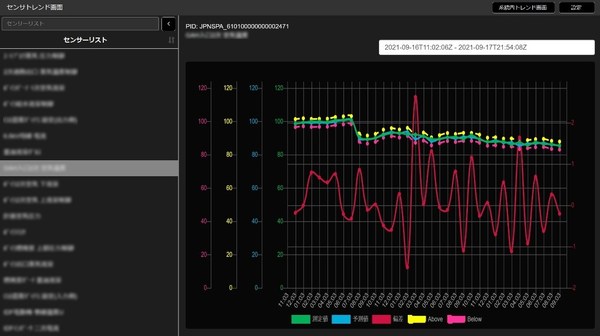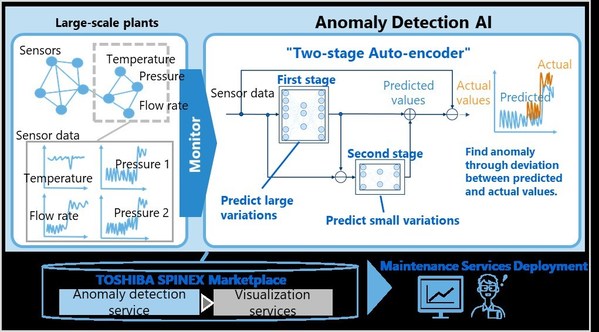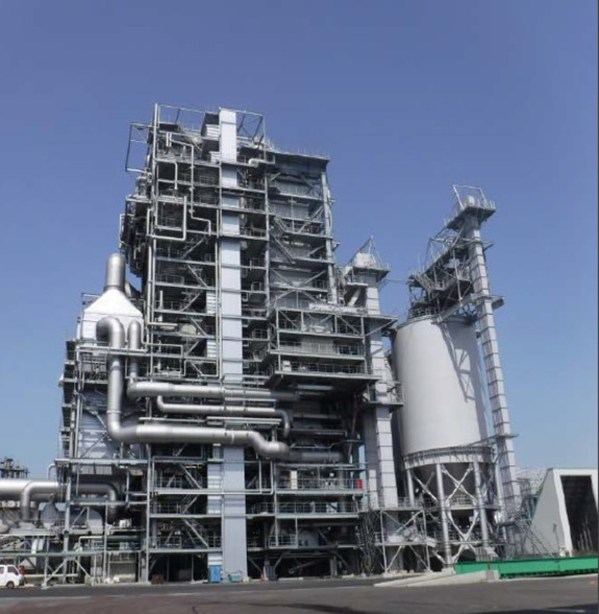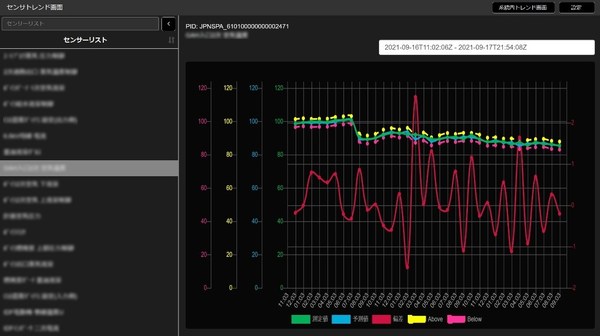Workforce transformation technology handles complex operating conditions across massive sensor data, contributes to efficient plant operation and maintenance.
 |
TOKYO, Dec. 7, 2021 /PRNewswire/ — Toshiba Corporation (TOKYO: 6502) has developed a new anomaly detection AI that enables large-scale industrial plants to overcome a widespread and growing challenge: using a small workforce to achieve constant and effective monitoring of thousands of sensors, and the accurate detection of anomalous signals hidden among small variations in sensor values. The AI can currently be applied to power and industrial plants that use pumps to move fluids, and is the first of its kind*1 to realize high-level accuracy in detecting anomalies in the complex interactions between plant operating conditions and massive sensor values. Toshiba will present the technology at the 21st IEEE International Conference ICDM2021 LITSA Workshop on Data Mining on December 7.
At the core of the AI is Toshiba’s "Two-stage Auto-encoder", a proprietary deep learning model that delivers highly accurate forecasts of sensor values in normal operating conditions; it detects anomaly hidden in massive sensor data by identifying deviations in actual values from the forecast values.
Industrial plants that must move fluids with pumps, such as power plants and water treatment facilities, use sensors to detect values for both small and large fluctuations in operation. Relatively small, rapid fluctuations appear simultaneously on a few sensors as a result of pump vibration or a local temperature change. Large fluctuations that occur on numerous sensors, with a larger amplitude and slower cycle, reflect changes in power and plant operation.
Commenting on the new AI, Susumu Naito, senior research scientist at Toshiba’s Corporate Research & Development Center, said: "The key factor behind the success of this technology is the deep and extensive knowhow Toshiba has gained from many years of experience in the energy and infrastructure business. We applied this to the design of two deep learning models, one for each fluctuation characteristic, and secured very high-level precision in predicting normal sensor values. These are compared with actual values to detect anomalies."
Tests of the AI on the open datasets of the Water Distribution (WADI) testbed*2 confirmed the highest level of detection accuracy in the industry, a 12% improvement against prior art*3. In another test, Toshiba also verified that the AI can recognize and report anomalous signs a full 6.8 days earlier than possible with manual monitoring by a trained operator. Early detection of anomalies allows for condition-based maintenance, and contributes to efficient plant operation and maintenance.
Toshiba is carrying out a demonstration experiment of the AI’s online monitoring and early-stage anomaly detection at the Mikawa power plant, operated by SIGMA POWER Ariake Corporation, a subsidiary of Toshiba Energy Systems & Solutions Corporation, in Omuta, Fukuoka, Japan (Figures 2 & 3).
Moving forward, Toshiba will ready proof-of-concept (PoC) systems and explore application on other types of industrial plants. Once it is commercialized, Toshiba plans to provide the AI as both an on-premises solution and as a cloud solution in the Toshiba SPINEX Marketplace, Toshiba’s IIoT service portal.
Notes
*1 Toshiba survey.
*2 Water Distribution (WADI): The scaled-down dataset, including anomalies, of the actual water treatment plant.
A. P. Mathur and N. O. Tippenhauer, "SWaT: a water treatment testbed for research and training on ICS security," Proceedings of 2016 International Workshop on Cyber-physical Systems for Smart Water Networks, pp. 31–36, April 2016.
*3 Anomaly detection machine-learning techniques such as UnSupervised Anomaly Detection (2020) and OminAnomaly (2019). Comparison of each of these methods is discussed in the following paper.
S. Naito, Y. Taguchi, K. Nakata, Y. Kato, "Anomaly Detection for Multivariate Time Series on Large-scale Fluid Handling Plant Using Two-stage Autoencoder."
About Toshiba Corporation
Toshiba leads a global group of companies that combines knowledge and capabilities from over 140 years of experience in a wide range of businesses—from energy and social infrastructure to electronic devices—with world-class capabilities in information processing, digital and AI technologies. These distinctive strengths support Toshiba’s continued evolution toward becoming an Infrastructure Services Company that promotes data utilization and digitization, and one of the world’s leading cyber-physical-systems technology companies. Guided by the Basic Commitment of the Toshiba Group, "Committed to People, Committed to the Future," Toshiba contributes to society’s positive development with services and solutions that lead to a better world. The Group and its 120,000 employees worldwide secured annual sales surpassing 3.1 trillion yen (US$27.5 billion) in fiscal year 2020. Find out more about Toshiba at www.global.toshiba/ww/outline/corporate.html






